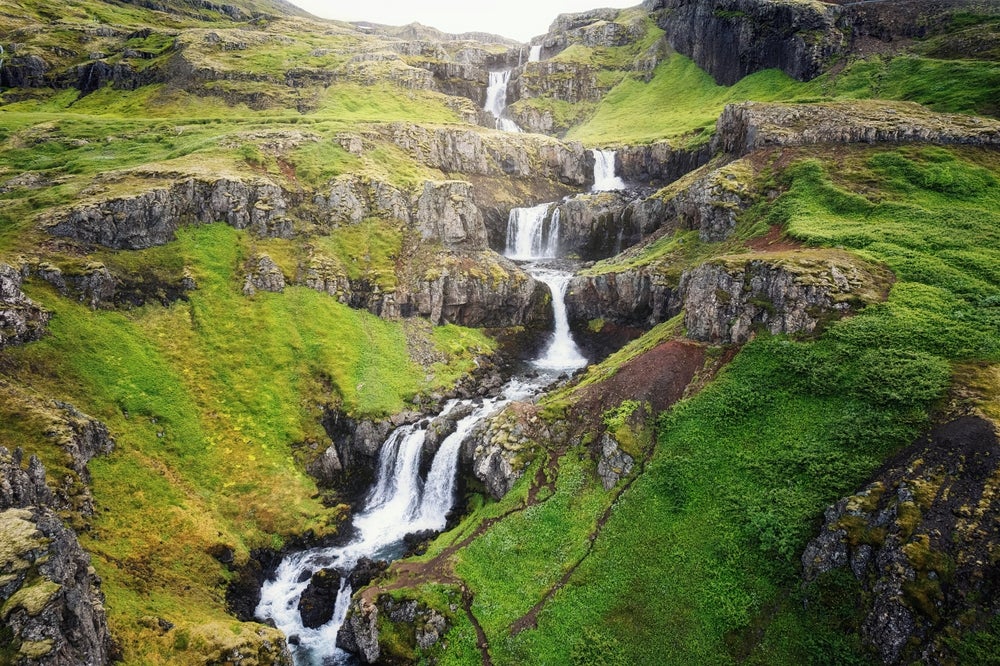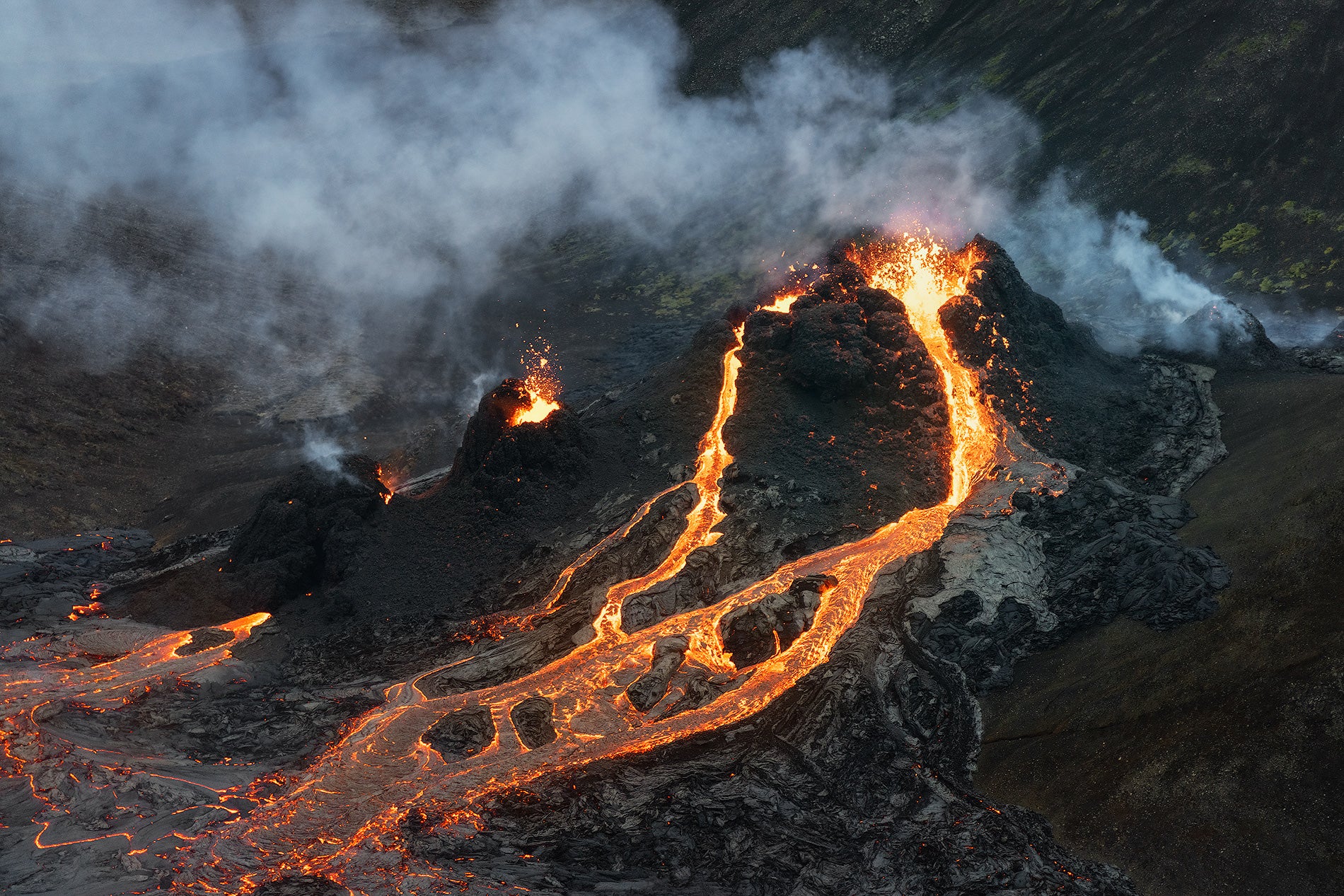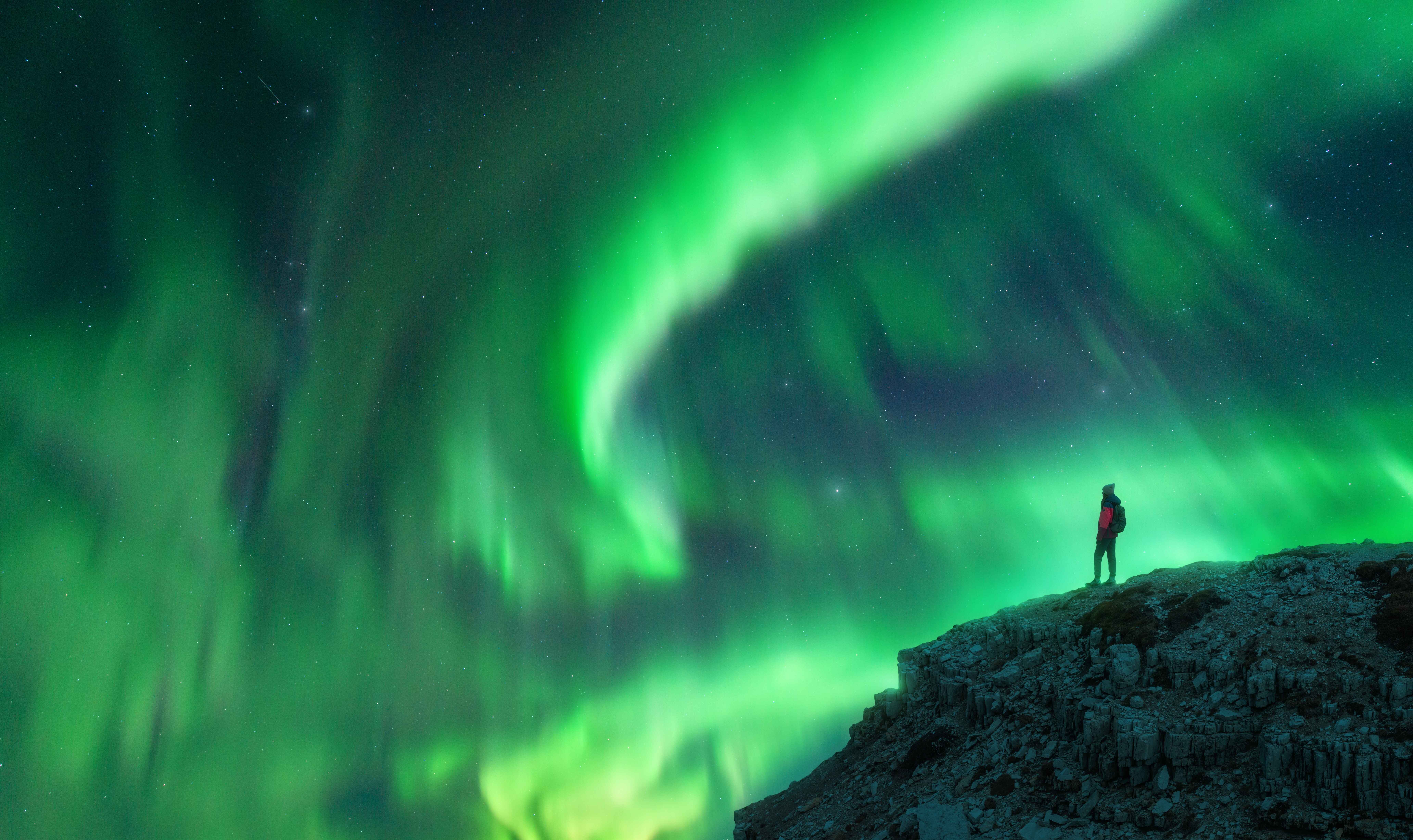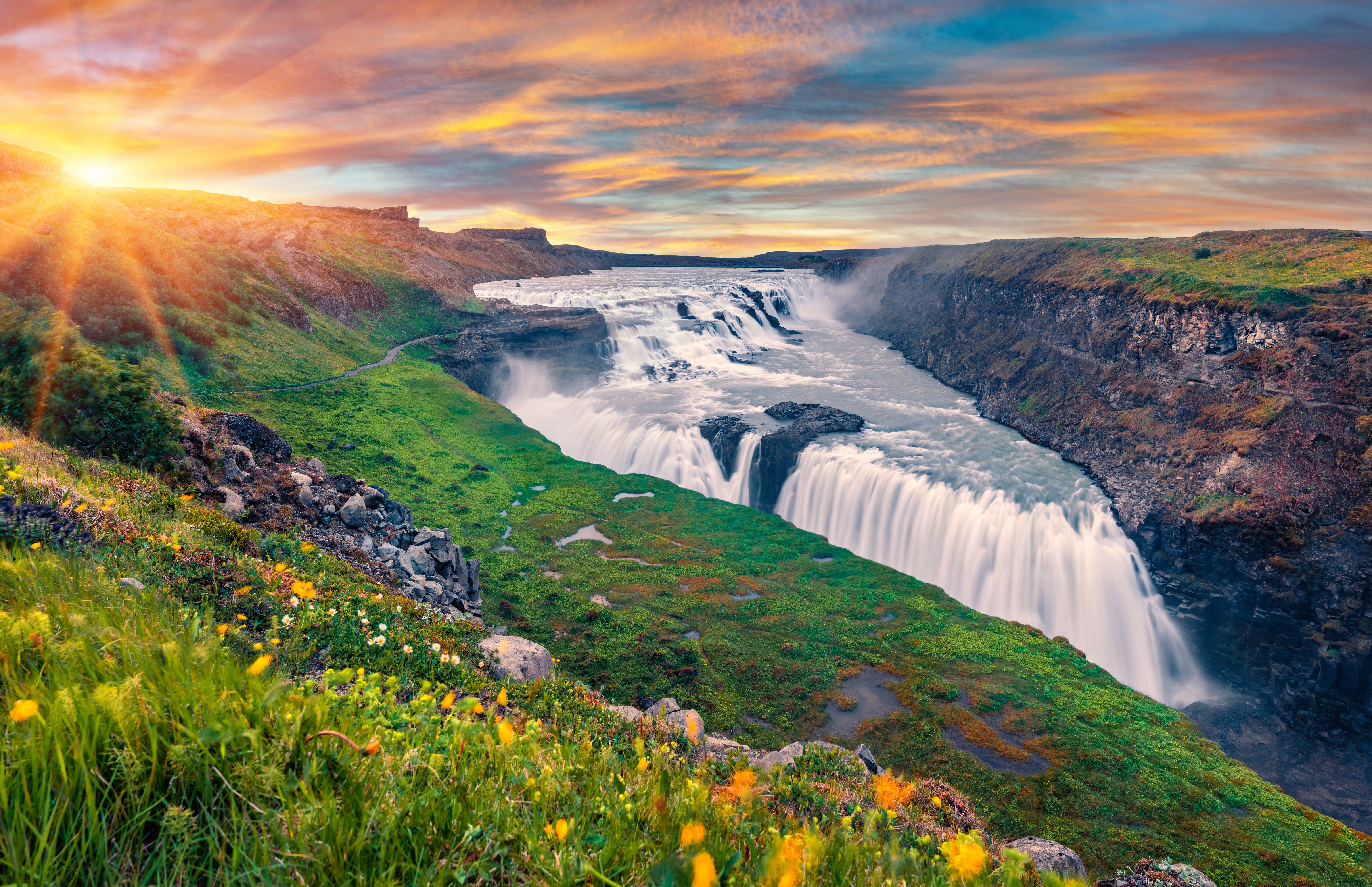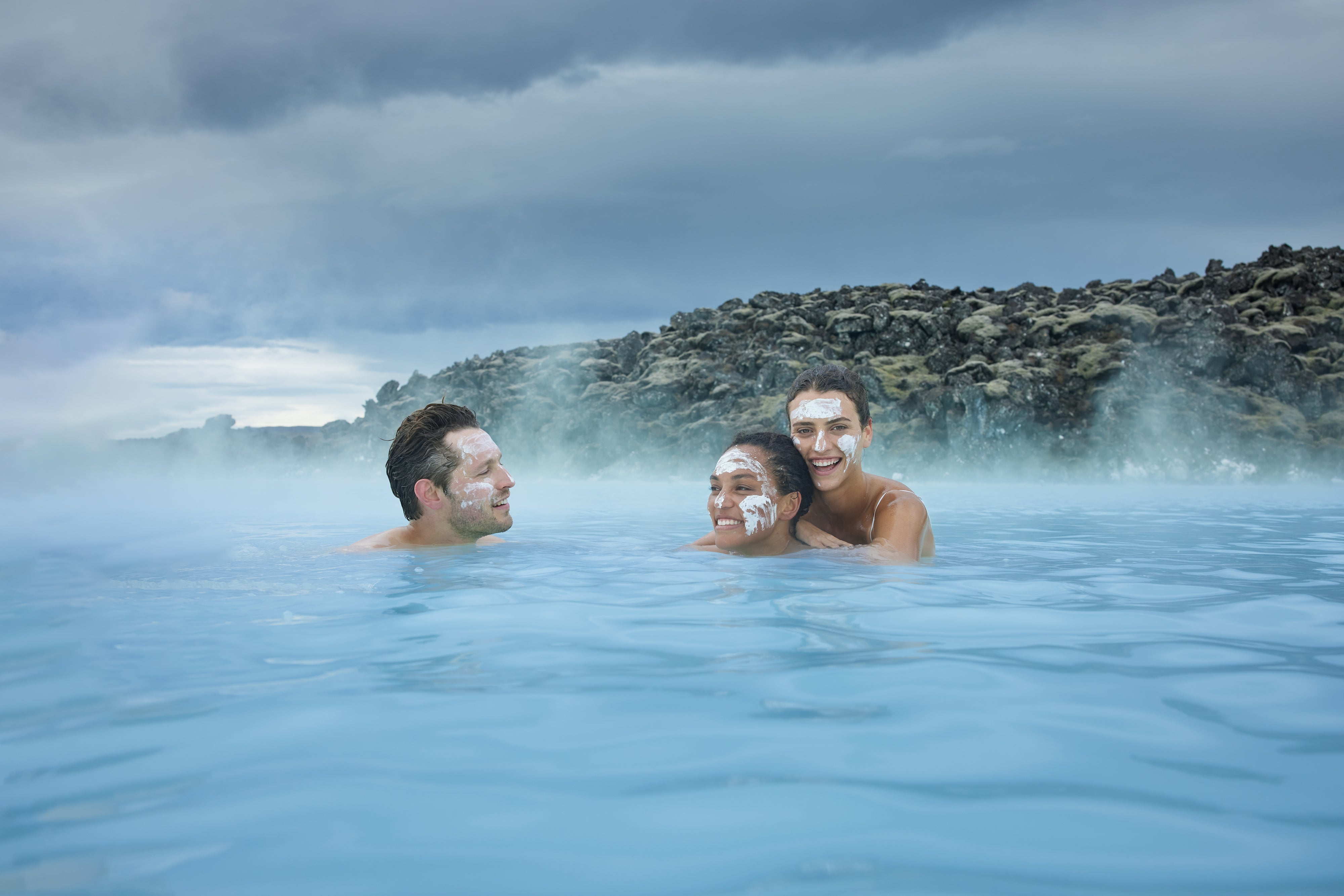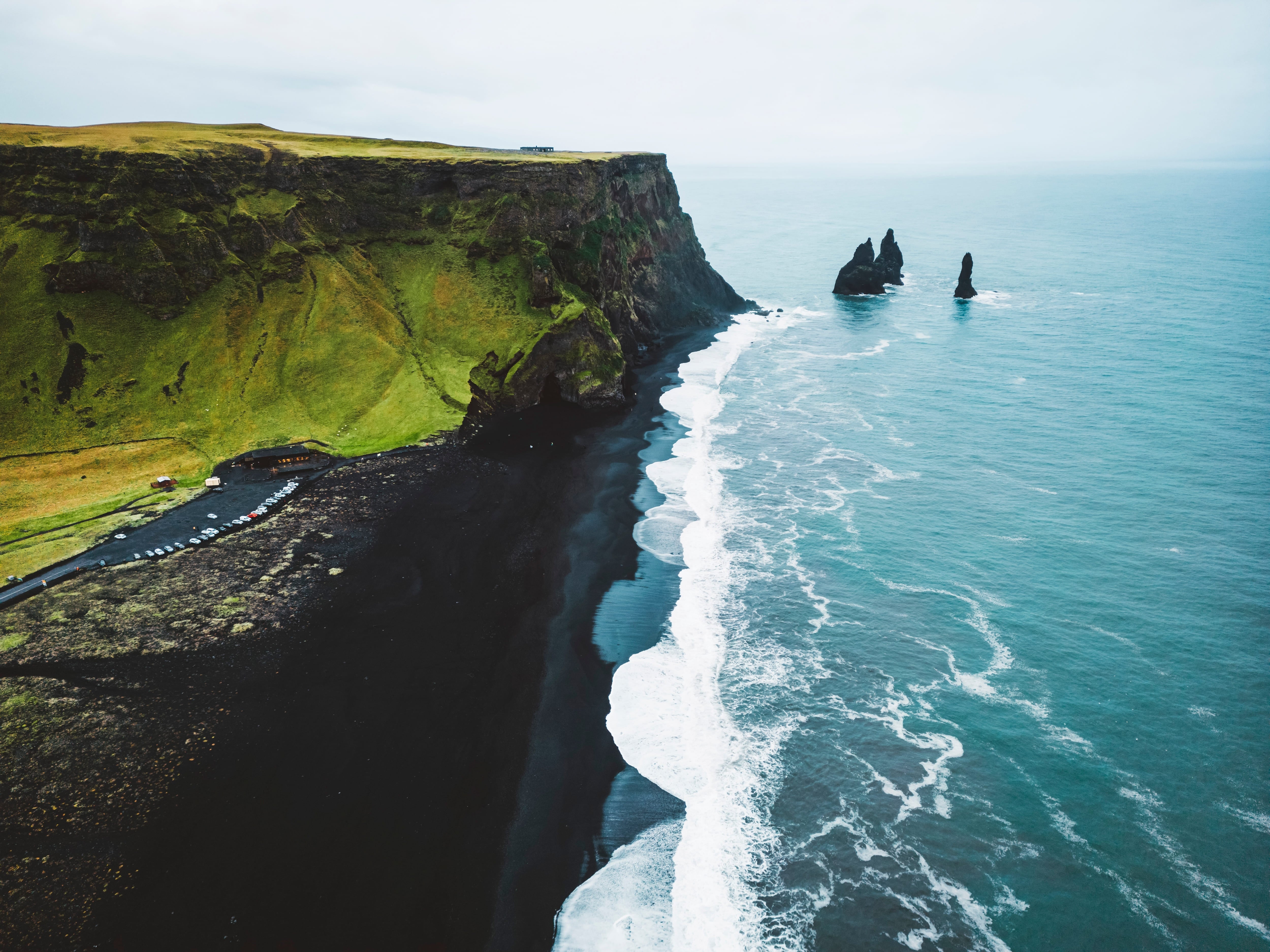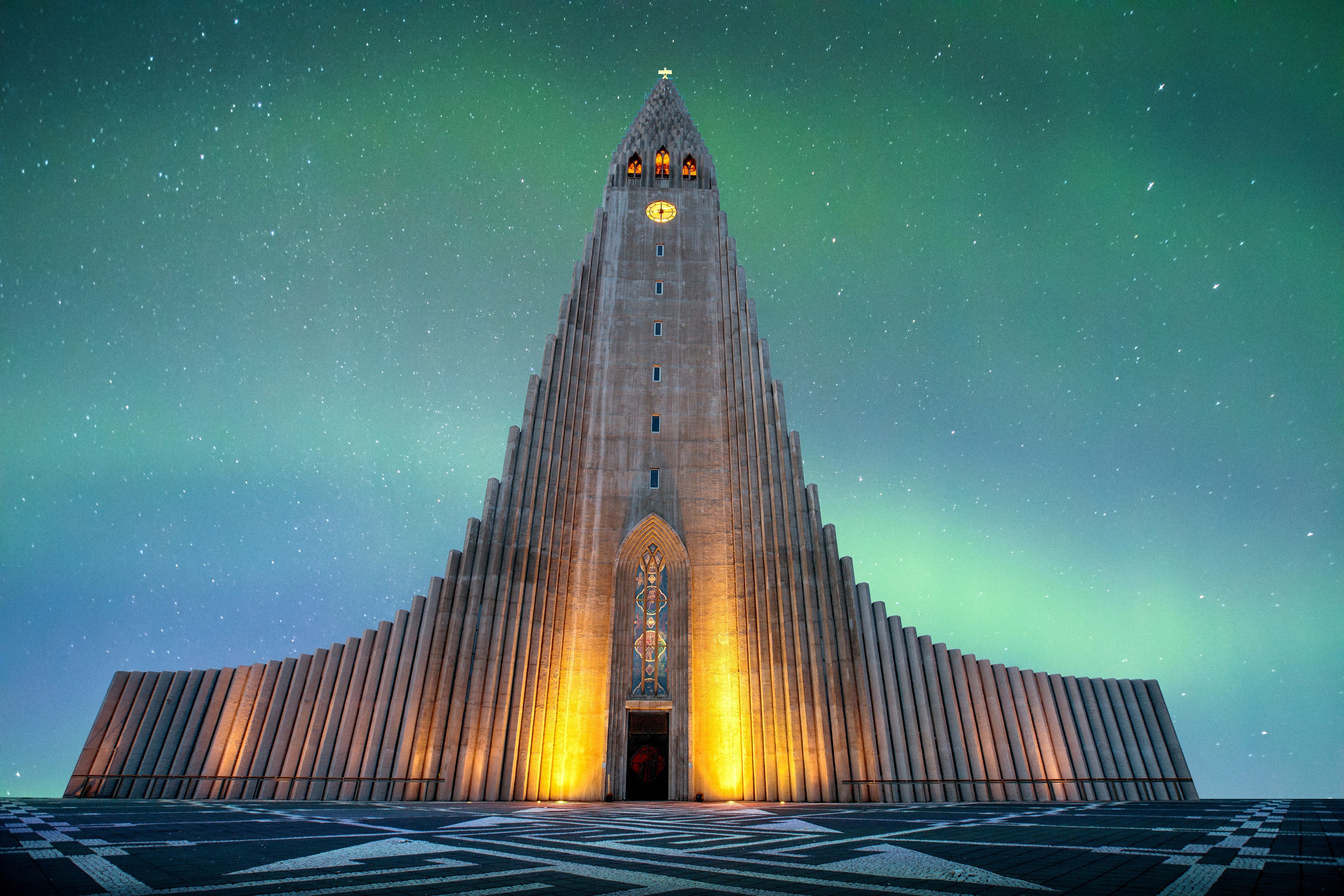Plan your adventure to see the glaciers in Iceland, some of the most remarkable natural wonders on Earth. These vast fields of ice hide volcanoes and create lagoons where icebergs drift toward the sea. Learn more about Iceland’s glaciers and the adventures they inspire.
Iceland is often called the land of ice and fire because it has both glaciers and volcanoes. A glacier forms when snow builds up over centuries and turns into moving ice. This movement creates crevasses, forms blue ice caves, and makes guided glacier tours one of the best ways to see them safely.
Why You Can Trust Our Content
Guide to Iceland is the most trusted travel platform in Iceland, helping millions of visitors each year. All our content is written and reviewed by local experts who are deeply familiar with Iceland. You can count on us for accurate, up-to-date, and trustworthy travel advice.
Travelers can choose from many activities, such as ice cave tours in Vatnajokull, snowmobile tours on Langjokull, a glacier hiking tour in Skaftafell, or glacier lagoon tours among drifting icebergs. Each offers a different way to experience Iceland’s frozen landscapes.
Facts About Glaciers in Iceland
-
What is a glacier: A large, slow-moving body of ice formed from compacted snow. In Iceland, glaciers shape the land and sit atop active volcanoes, creating a mix of fire and ice.
-
How many glaciers are in Iceland: Around 269 named glaciers, from massive ice caps like Vatnajokull to smaller outlet glaciers.
-
How much of Iceland is covered by glaciers: About 11% of the country. Vatnajokull alone spans roughly 8%.
-
How old are glaciers in Iceland: Most formed about 2,500 years ago. Some parts of Vatnajokull contain ice that is thousands of years old.
-
Are Iceland’s glaciers melting: Yes. Since 2000, glaciers have lost over 7% of their total volume. Some smaller ones could disappear within the next century.
Characteristics of Glaciers in Iceland
 Glaciers in Iceland are not all the same. They vary in size and shape, and they also connect closely to Iceland’s volcanoes and seasonal weather. Knowing these differences helps visitors understand what they can expect to see and do on glacier tours.
Glaciers in Iceland are not all the same. They vary in size and shape, and they also connect closely to Iceland’s volcanoes and seasonal weather. Knowing these differences helps visitors understand what they can expect to see and do on glacier tours.
Glacier Types in Iceland
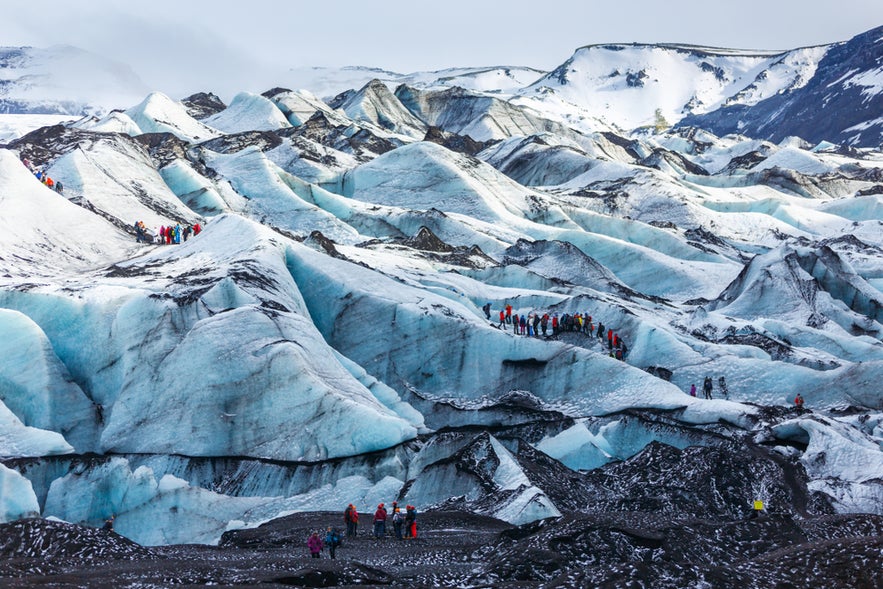 The main glacier types in Iceland are ice caps and outlet glaciers. Ice caps are huge sheets of ice that cover mountains and highlands. These ice caps create outlet glaciers, which are long rivers of ice that slowly reach down into valleys.
The main glacier types in Iceland are ice caps and outlet glaciers. Ice caps are huge sheets of ice that cover mountains and highlands. These ice caps create outlet glaciers, which are long rivers of ice that slowly reach down into valleys.
The best example of an ice cap is Vatnajokull, the largest glacier in Europe, which has many outlet glaciers you can visit on guided hikes.
Volcanoes and Glaciers in Iceland
 Many glaciers in Iceland sit on top of active volcanoes. When these volcanoes erupt under the ice, they create subglacial eruptions (eruptions under the glacier) and sudden floods called jokulhlaup. You may not see these events, but they explain why Iceland has so many striking black sand plains.
Many glaciers in Iceland sit on top of active volcanoes. When these volcanoes erupt under the ice, they create subglacial eruptions (eruptions under the glacier) and sudden floods called jokulhlaup. You may not see these events, but they explain why Iceland has so many striking black sand plains.
Seasonal Access to Glaciers in Iceland
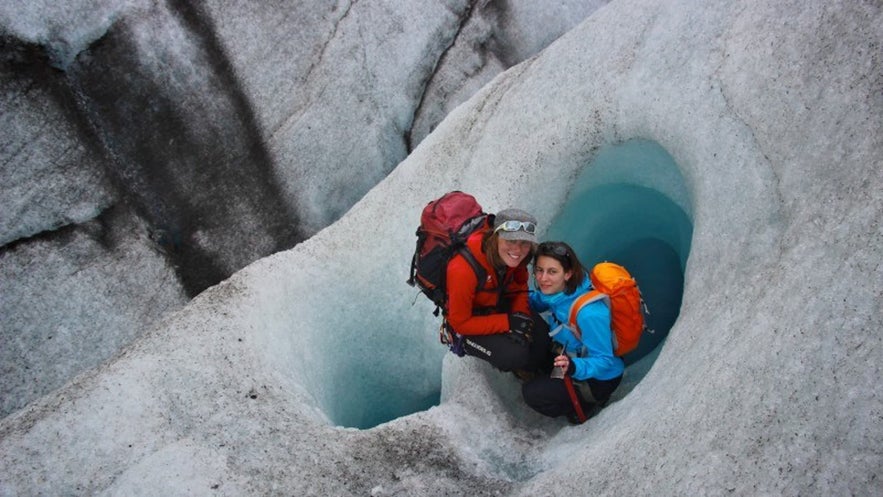 The way you experience glaciers changes with the season. In summer, you can go hiking on the ice and try kayaking tours on glacier lagoons. In winter, you can safely enter natural ice caves because the ice is stable in cold weather.
The way you experience glaciers changes with the season. In summer, you can go hiking on the ice and try kayaking tours on glacier lagoons. In winter, you can safely enter natural ice caves because the ice is stable in cold weather.
Snowmobiling is possible in both seasons, and the man-made ice tunnel in Langjokull can be visited all year.
Where Are the Glaciers in Iceland?
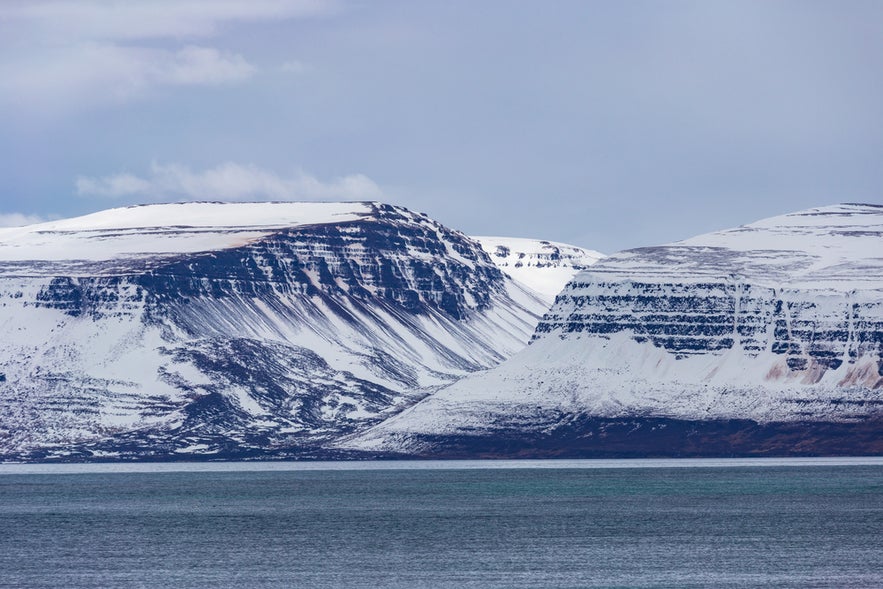 Iceland is home to some of Europe’s largest and most impressive glaciers, each with its own character and landscape. Most of them are found in the South and Southeast, though others can be seen in the Highlands, Westfjords, and West Iceland. Below are the main glaciers in Iceland and where to find them.
Iceland is home to some of Europe’s largest and most impressive glaciers, each with its own character and landscape. Most of them are found in the South and Southeast, though others can be seen in the Highlands, Westfjords, and West Iceland. Below are the main glaciers in Iceland and where to find them.
-
Vatnajokull Glacier: Found in Southeast Iceland within Vatnajokull National Park, this massive ice cap stretches from the Highlands to the South Coast and dominates much of the region’s landscape.
-
Langjokull Glacier: Located in West Iceland between the Highlands and Borgarfjordur Valley. It’s the closest large glacier to Reykjavik and home to the Into the Glacier Ice Tunnels and snowmobiling tours.
-
Hofsjokull Glacier: Situated in the Central Highlands between Langjokull and Vatnajokull. It’s Iceland’s third-largest glacier and the source of several major rivers.
-
Myrdalsjokull Glacier: Found in South Iceland near Vik. It covers the Katla Volcano and feeds outlet glaciers such as Solheimajokull and Kotlujokull, both popular for guided tours.
-
Eyjafjallajokull Glacier: Lies west of Myrdalsjokull along Iceland’s South Coast. Easily visible from the Ring Road, this glacier-topped volcano gained fame after its 2010 eruption.
-
Drangajokull Glacier: Located in the remote Westfjords, north of Isafjordur. It’s the northernmost glacier in Iceland and the only one that sits entirely below 3,300 feet (1,000 meters).
-
Snaefellsjokull Glacier: Found at the western tip of the Snaefellsnes Peninsula in West Iceland. This glacier-capped volcano overlooks the North Atlantic and inspired Jules Verne’s "Journey to the Center of the Earth."
Another glacier worth noting is Ok, which was located in West Iceland. It was declared dead in 2014 due to climate change, becoming the first Icelandic glacier to lose its glacier status.
Map of Glaciers in Iceland
A map of glaciers in Iceland helps travelers see where the major ice caps are located. This includes Vatnajokull, Langjokull, Myrdalsjokull, Eyjafjallajokull, Snaefellsjokull, Hofsjokull, and Drangajokull.
Which Is the Closest Glacier to Reykjavik?
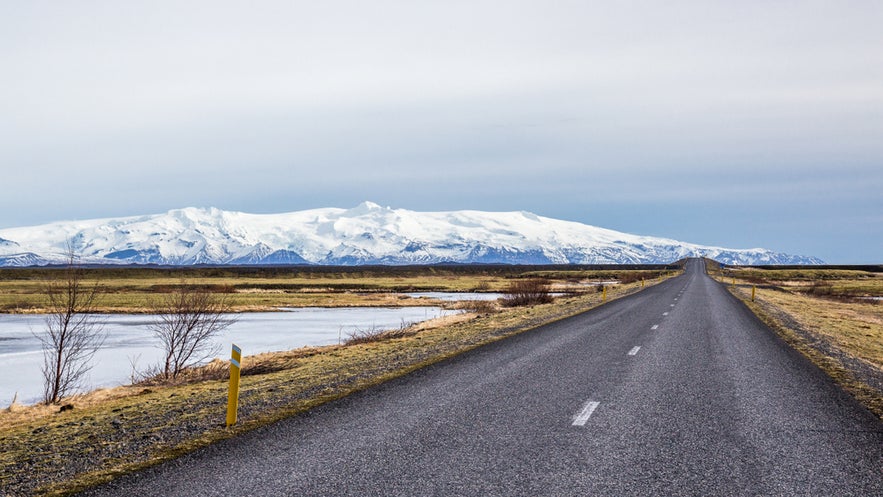 The closest glaciers to Reykjavik are Eyjafjallajokull and Solheimajokull, an outlet glacier of Myrdalsjokull. They're on the South Coast, about 100 miles (160 kilometers) from Reykjavik, or a 2.5-hour drive.
The closest glaciers to Reykjavik are Eyjafjallajokull and Solheimajokull, an outlet glacier of Myrdalsjokull. They're on the South Coast, about 100 miles (160 kilometers) from Reykjavik, or a 2.5-hour drive.
It's possible to go snowmobiling on Eyjafjallajokull or hike to its dramatic peak, but Solheimajokull Glacier is more accessible. It's the most popular place for a guided glacier hike in Iceland.
Another option is Langjokull, which is about 95 miles (150 kilometers) from Reykjavik, or a 2-hour drive. Langjokull is well known for snowmobiling tours and its man-made ice tunnels, which are open year-round.
Major Glaciers of Iceland
A simple look at Iceland’s largest glaciers, shown as icy peaks by size.
Vatnajokull
3,050 sq mi (7,900 sq km)
Langjokull
360 sq mi (935 sq km)
Hofsjokull
340 sq mi (890 sq km)
Myrdalsjokull
230 sq mi (590 sq km)
Drangajokull
62 sq mi (160 sq km)
Eyjafjallajokull
31 sq mi (80 sq km)
Snaefellsjokull
4 sq mi (10 sq km)
Each peak represents the relative size of Iceland’s glaciers, with Vatnajokull towering above the rest.
The major glaciers of Iceland cover vast areas of the island and shape many of its landscapes. Each has its own character: some are famous for glacier lagoons and ice caves, while others are known for snowmobile adventures or cultural significance.
Vatnajokull Glacier
 Vatnajokull Glacier is the largest glacier in Iceland and the largest in Europe, covering about 8% of Iceland’s land area. It is located in the Southeast of Iceland and has dozens of glacier tongues (outlet glaciers) that flow in every direction.
Vatnajokull Glacier is the largest glacier in Iceland and the largest in Europe, covering about 8% of Iceland’s land area. It is located in the Southeast of Iceland and has dozens of glacier tongues (outlet glaciers) that flow in every direction.
What Are the Main Glacier Tongues of Vatnajokull?
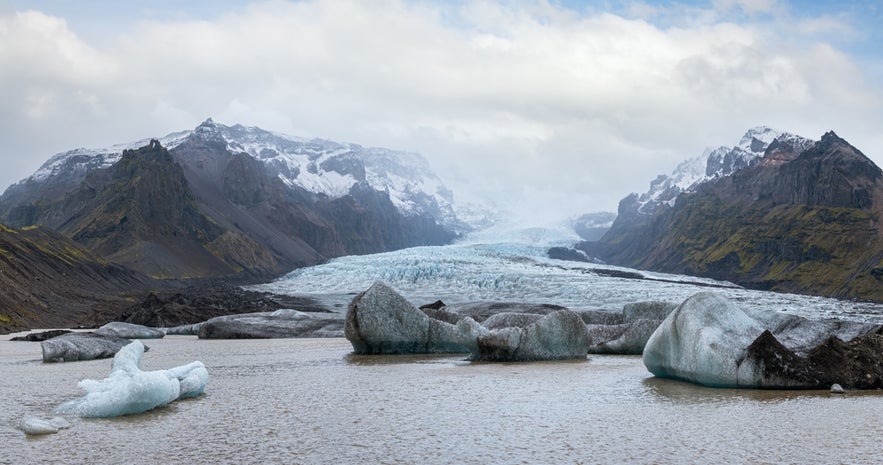 Vatnajokull is so large that it has many outlet glaciers. For travelers, they provide the best access to the glacier through guided hikes, ice climbing, and photography stops along the South Coast.
Vatnajokull is so large that it has many outlet glaciers. For travelers, they provide the best access to the glacier through guided hikes, ice climbing, and photography stops along the South Coast.
The main glacier tongues of Vatnajokull include:
-
Breidamerkurjokull: The best known, as it feeds Jokulsarlon Glacier Lagoon and Diamond Beach, two of Iceland’s most popular natural attractions.
-
Fjallsjokull: Flows into Fjallsarlon, a smaller and quieter glacier lagoon located just west of Jokulsarlon.
-
Heinabergsjokull: Ends at Heinabergslon Lagoon, a remote and scenic spot for kayaking tours.
-
Skeidararjokull: One of the widest glacier tongues in Iceland, stretching across the Skeidararsandur Plain.
-
Skaftafellsjokull: Located in the Skaftafell Nature Reserve, this glacier is one of the most accessible for visitors and a popular stop for easy walks and guided glacier hikes.
-
Falljokull: Popular for guided glacier hikes, Falljokull is located near Skaftafell.
-
Oraefajokull Outlets: Surrounding Iceland’s highest peak, Hvannadalshnjukur.
-
Skalafellsjokull: Less visited but accessible for snowmobiling and ice climbing.
Vatnajokull National Park
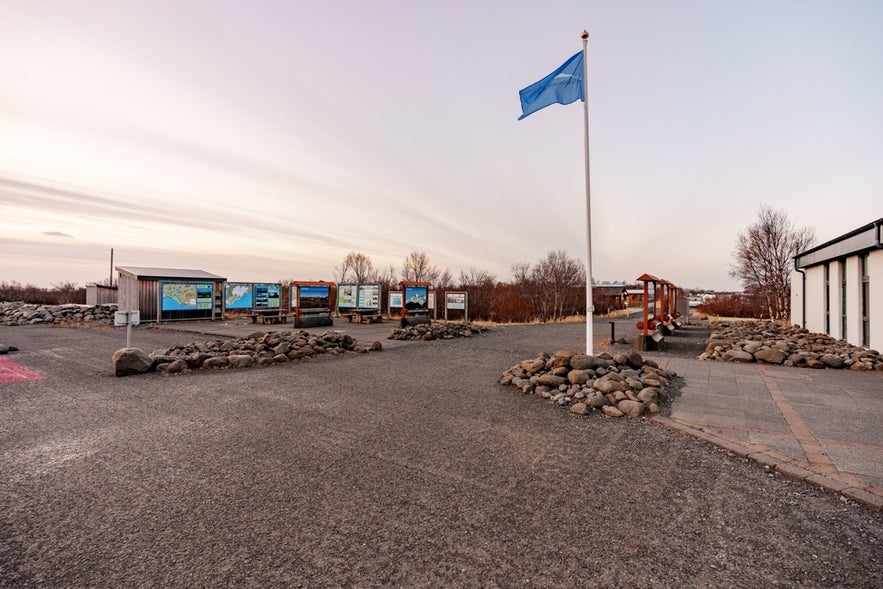 Many of Vatnajokull’s glacier tongues can be visited in Skaftafell, a protected area that forms part of Vatnajokull National Park. In 2008, Skaftafell was merged with Jokulsargljufur, a canyon area in North Iceland famous for the Dettifoss Waterfall, to create Vatnajokull National Park.
Many of Vatnajokull’s glacier tongues can be visited in Skaftafell, a protected area that forms part of Vatnajokull National Park. In 2008, Skaftafell was merged with Jokulsargljufur, a canyon area in North Iceland famous for the Dettifoss Waterfall, to create Vatnajokull National Park.
Today, the park covers the entire glacier and its surroundings. At 12,000 square kilometers (4,600 square miles), it is the largest national park in Europe.
Skaftafell remains the most visited hub, with a visitor center, campsite, cafeteria, and marked hiking trails. It is also the starting point for many guided tours on Vatnajokull’s glacier tongues.
Jokulsarlon Glacier Lagoon and Diamond Beach
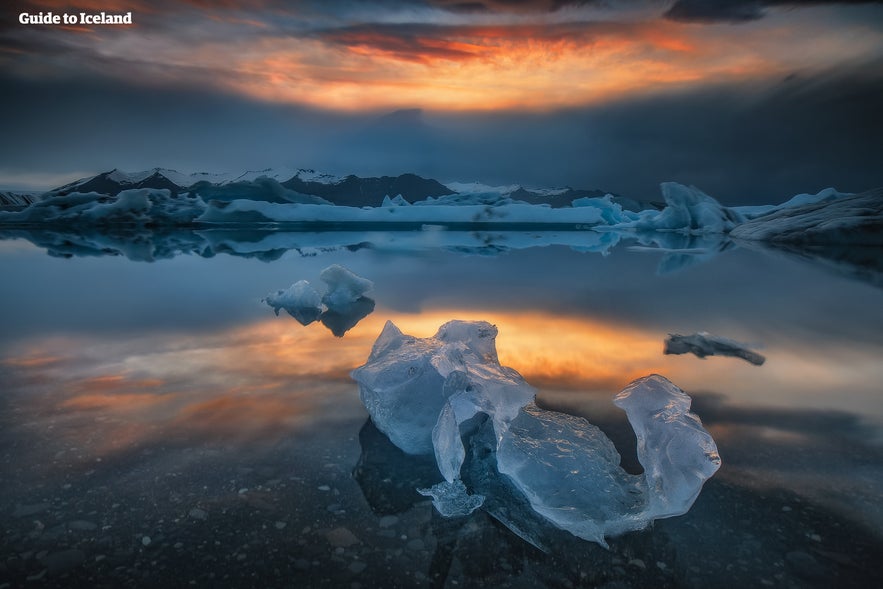
Icebergs break from Breidamerkurjokull and drift slowly across the lagoon before reaching the Atlantic Ocean. Many visitors choose a Jokulsarlon boat tour to get close to the icebergs and experience the lagoon from the water.
Just across the road is Diamond Beach, where smaller pieces of ice from the lagoon wash up on the black volcanic sand. The clear ice shines like diamonds in the sunlight, creating one of Iceland’s most famous views.
Crystal Ice Cave
 One of the most famous natural ice caves in Iceland is the Crystal Ice Cave, which forms inside the Breidamerkurjokull Outlet Glacier of Vatnajokull.
One of the most famous natural ice caves in Iceland is the Crystal Ice Cave, which forms inside the Breidamerkurjokull Outlet Glacier of Vatnajokull.
This cave is known for its blue walls, created as the weight of the glacier squeezes out air bubbles from the ice. Sunlight passing through the ice gives the cave its deep, glowing color.
The Crystal Ice Cave can only be visited in winter, usually from November to March, when the ice is stable and safe. Each year, the cave forms in a slightly different shape, which makes every Crystal Ice Cave tour a unique experience.
Langjokull Glacier
 Langjokull Glacier is the second-largest glacier in Iceland, covering about 950 square kilometers (366 square miles). Its name means “the Long Glacier”, and it stretches almost 50 kilometers (31 miles) in length.
Langjokull Glacier is the second-largest glacier in Iceland, covering about 950 square kilometers (366 square miles). Its name means “the Long Glacier”, and it stretches almost 50 kilometers (31 miles) in length.
It is located in the western Highlands, northeast of the capital, and is one of the most accessible glaciers for day trips from Reykjavik.
Into the Glacier Ice Tunnel
 Langjokull is home to the Into the Glacier Ice Tunnel, the only man-made tunnel inside a glacier in Iceland. The tunnel was opened in 2015 and stretches nearly 500 meters (1,640 feet) into the ice.
Langjokull is home to the Into the Glacier Ice Tunnel, the only man-made tunnel inside a glacier in Iceland. The tunnel was opened in 2015 and stretches nearly 500 meters (1,640 feet) into the ice.
Visitors can take an Into the Glacier Ice Tunnel tour to walk through glowing blue corridors and chambers that reveal the inner layers of the glacier. Unlike natural ice caves that only appear in winter, the ice tunnel is open all year, which makes it one of the most reliable glacier experiences in Iceland.
Langjokull and the Golden Circle
 Langjokull is often combined with the Golden Circle, Iceland’s most famous sightseeing route. The glacier feeds the Hvita River, which flows through Gullfoss Waterfall, one of the main Golden Circle stops.
Langjokull is often combined with the Golden Circle, Iceland’s most famous sightseeing route. The glacier feeds the Hvita River, which flows through Gullfoss Waterfall, one of the main Golden Circle stops.
Some Langjokull snowmobiling tours begin at Gullfoss or the nearby Geysir Geothermal Area. Both are popular parts of the route, together with Thingvellir National Park.
Travelers can easily combine a Golden Circle tour with a Langjokull snowmobiling adventure on the same day. This makes Langjokull one of the most accessible glaciers to visit from Reykjavik.
Myrdalsjokull Glacier
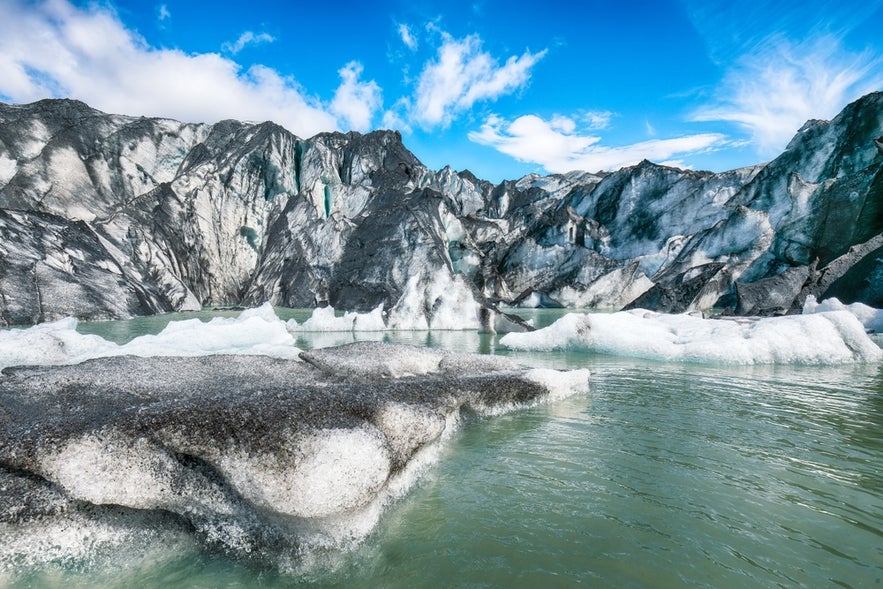 Myrdalsjokull Glacier is the fourth-largest glacier in Iceland, covering about 600 square kilometers (232 square miles). It lies on the South Coast by the town of Vik and sits directly above the powerful Katla Volcano, one of the most active volcanoes in Iceland.
Myrdalsjokull Glacier is the fourth-largest glacier in Iceland, covering about 600 square kilometers (232 square miles). It lies on the South Coast by the town of Vik and sits directly above the powerful Katla Volcano, one of the most active volcanoes in Iceland.
What Are the Main Glacier Tongues of Myrdalsjokull?
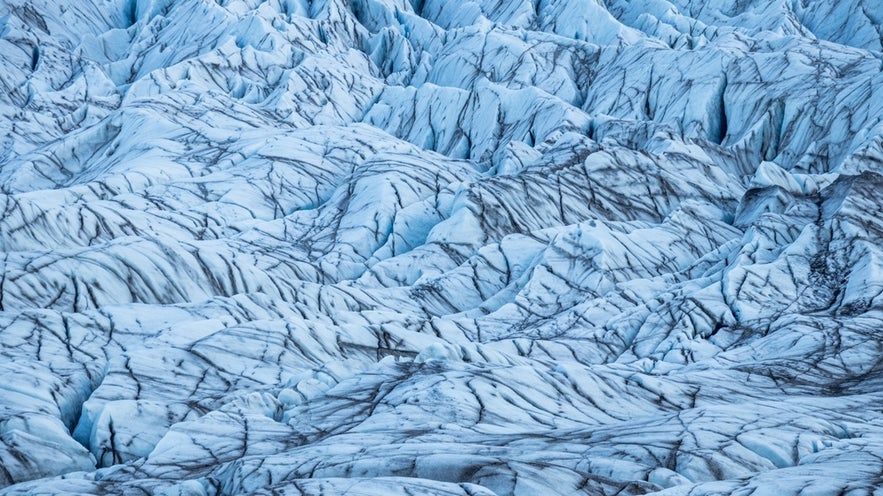 Myrdalsjokull has several outlet glaciers that reach toward the South Coast. Some of these glacier tongues are the main access points for tours and activities.
Myrdalsjokull has several outlet glaciers that reach toward the South Coast. Some of these glacier tongues are the main access points for tours and activities.
The best known is Solheimajokull, one of the most accessible glaciers in Iceland. On the eastern side is Kotlujokull, where tours depart for the Katla Ice Cave, a natural cave that stays open even in summer.
Solheimajokull
 Solheimajokull is the most visited outlet of Myrdalsjokull and one of the easiest glaciers in Iceland to reach. It lies just a short drive off the Ring Road, about 2.5 hours from Reykjavik.
Solheimajokull is the most visited outlet of Myrdalsjokull and one of the easiest glaciers in Iceland to reach. It lies just a short drive off the Ring Road, about 2.5 hours from Reykjavik.
Visitors can walk from the parking area to the glacier’s edge or join a guided Solheimajokull glacier hike with crampons and helmets. A small lagoon has also formed at the base of Solheimajokull in recent years, where pieces of ice break off from the glacier tongue and float in the water.
Katla Ice Cave
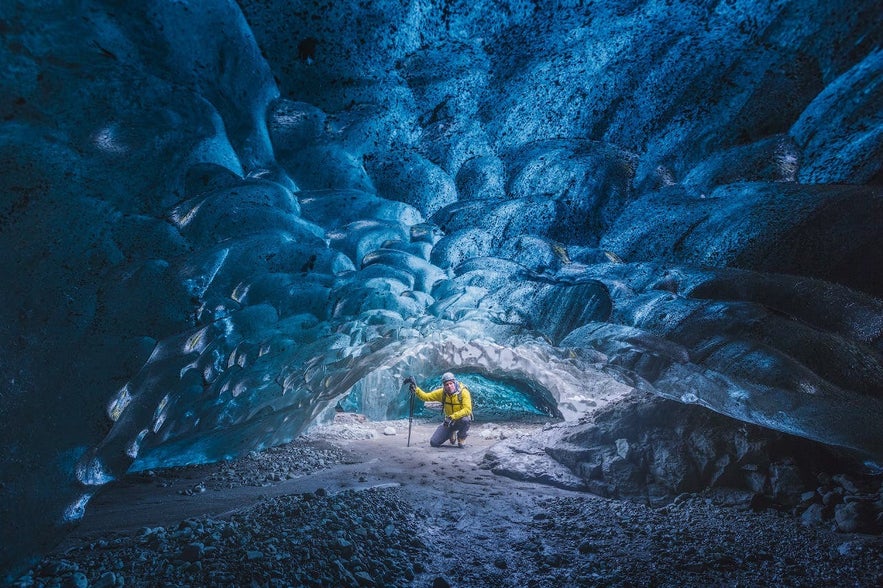 The Katla Ice Cave is one of Iceland’s most unique natural ice caves because it can be visited in summer as well as winter. It forms under the Kotlujokull Outlet of Myrdalsjokull.
The Katla Ice Cave is one of Iceland’s most unique natural ice caves because it can be visited in summer as well as winter. It forms under the Kotlujokull Outlet of Myrdalsjokull.
Tours depart from the town of Vik, where travelers can ride in a super jeep onto the glacier before entering the Katla Ice Cave with a guide. Inside, layers of black volcanic ash are frozen into the blue ice, creating patterns that reflect the glacier’s volcanic setting.
Katla Geopark
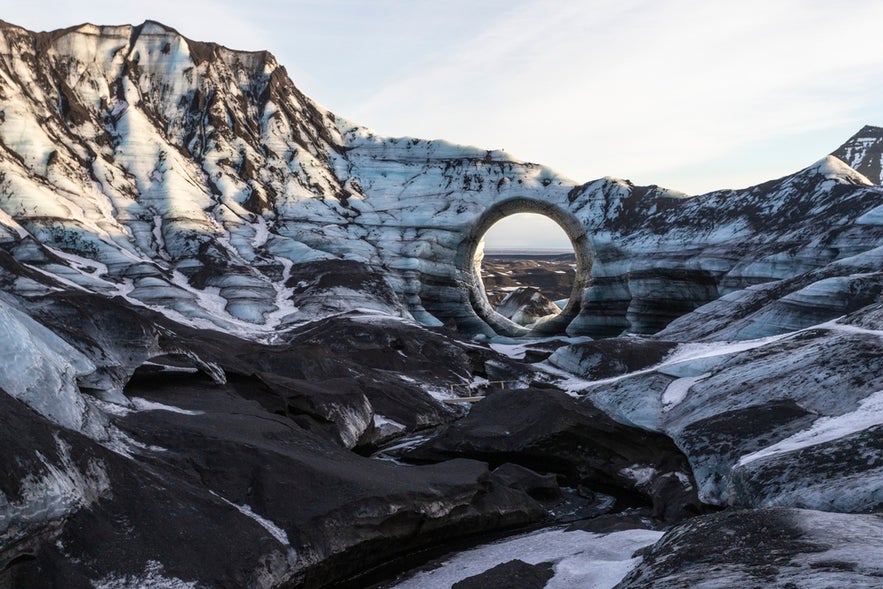 Myrdalsjokull lies within Katla Geopark, a protected area named after the Katla Volcano beneath the glacier. Established in 2011, it was Iceland’s first UNESCO Global Geopark and covers around 9,500 square kilometers (3,670 square miles) of the South Coast.
Myrdalsjokull lies within Katla Geopark, a protected area named after the Katla Volcano beneath the glacier. Established in 2011, it was Iceland’s first UNESCO Global Geopark and covers around 9,500 square kilometers (3,670 square miles) of the South Coast.
Katla Geopark includes many of the South Coast’s most famous attractions. Visitors can explore the black sands of Reynisfjara Beach, the cliffs of Dyrholaey, and waterfalls such as Skogafoss and Seljalandsfoss.
It also covers both Myrdalsjokull Glacier and Eyjafjallajokull, linking two of Iceland’s most famous volcano-glacier systems in one region.
Eyjafjallajokull Glacier
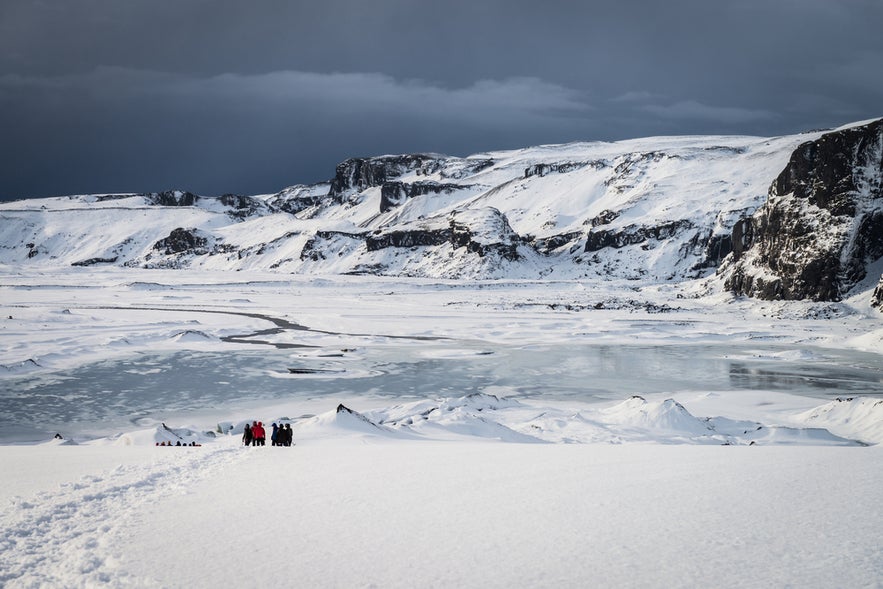 Eyjafjallajokull Glacier is located on Iceland’s South Coast, between Myrdalsjokull and the Westman Islands. Smaller than Vatnajokull or Langjokull, it sits on top of the Eyjafjallajokull Volcano. The glacier became world-famous in 2010, when the volcano beneath it erupted and sent ash clouds across Europe.
Eyjafjallajokull Glacier is located on Iceland’s South Coast, between Myrdalsjokull and the Westman Islands. Smaller than Vatnajokull or Langjokull, it sits on top of the Eyjafjallajokull Volcano. The glacier became world-famous in 2010, when the volcano beneath it erupted and sent ash clouds across Europe.
2010 Eyjafjallajokull Eruption
 In April 2010, Eyjafjallajokull Volcano erupted beneath the glacier ice, melting large sections and producing enormous ash clouds that spread across Europe. The eruption disrupted international air travel for weeks and brought global attention to Iceland.
In April 2010, Eyjafjallajokull Volcano erupted beneath the glacier ice, melting large sections and producing enormous ash clouds that spread across Europe. The eruption disrupted international air travel for weeks and brought global attention to Iceland.
On the ground, it reshaped Gigjokull, the glacier tongue on Eyjafjallajokull’s northern side. Huge floods of water, ice, and ash rushed down the valley. Since then, Gigjokull has shrunk a great deal, and visitors can still see how the valley was torn open during the eruption.
Snaefellsjokull Glacier
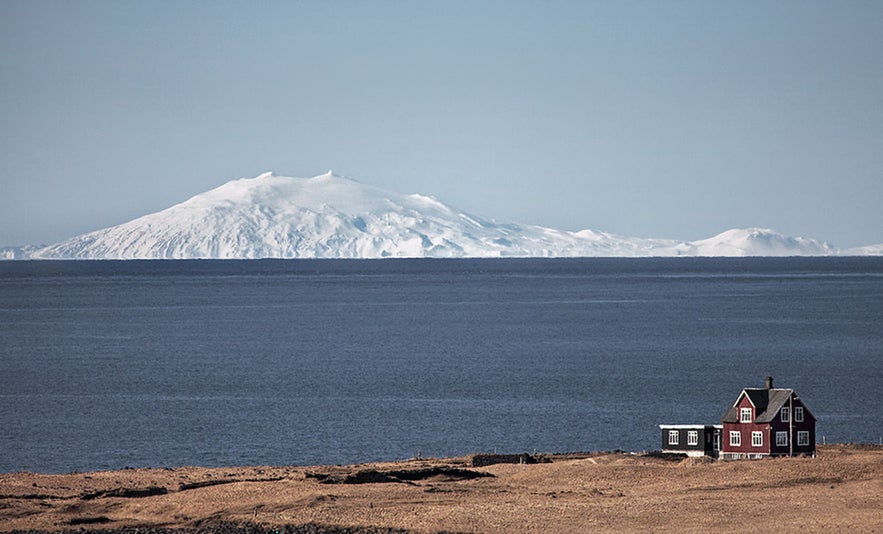 Snaefellsjokull Glacier is one of the most famous glaciers in Iceland, even though it is much smaller than Vatnajokull, Langjokull, or Myrdalsjokull. Covering about 170 square kilometers (66 square miles), it sits on top of a stratovolcano at the tip of the Snaefellsnes Peninsula in West Iceland.
Snaefellsjokull Glacier is one of the most famous glaciers in Iceland, even though it is much smaller than Vatnajokull, Langjokull, or Myrdalsjokull. Covering about 170 square kilometers (66 square miles), it sits on top of a stratovolcano at the tip of the Snaefellsnes Peninsula in West Iceland.
Snaefellsjokull is best known for its cultural and literary importance. It was the setting for Jules Verne’s classic novel “Journey to the Center of the Earth,” where the adventure begins through its crater.
The glacier has long been linked with Icelandic folklore, mystery, and even supernatural tales. On a clear day, it can be seen from Reykjavik, nearly 120 kilometers (75 miles) away across Faxafloi Bay.
Snaefellsjokull National Park
 The glacier is the centerpiece of Snaefellsjokull National Park, the only coastal national park in Iceland. The area combines volcanic peaks, lava fields, caves, and cliffs with views of the glacier in the background. Surrounding highlights include Arnarstapi Cliffs, Djupalonssandur Beach, and the fishing villages of Hellnar and Olafsvik.
The glacier is the centerpiece of Snaefellsjokull National Park, the only coastal national park in Iceland. The area combines volcanic peaks, lava fields, caves, and cliffs with views of the glacier in the background. Surrounding highlights include Arnarstapi Cliffs, Djupalonssandur Beach, and the fishing villages of Hellnar and Olafsvik.
Hofsjokull Glacier
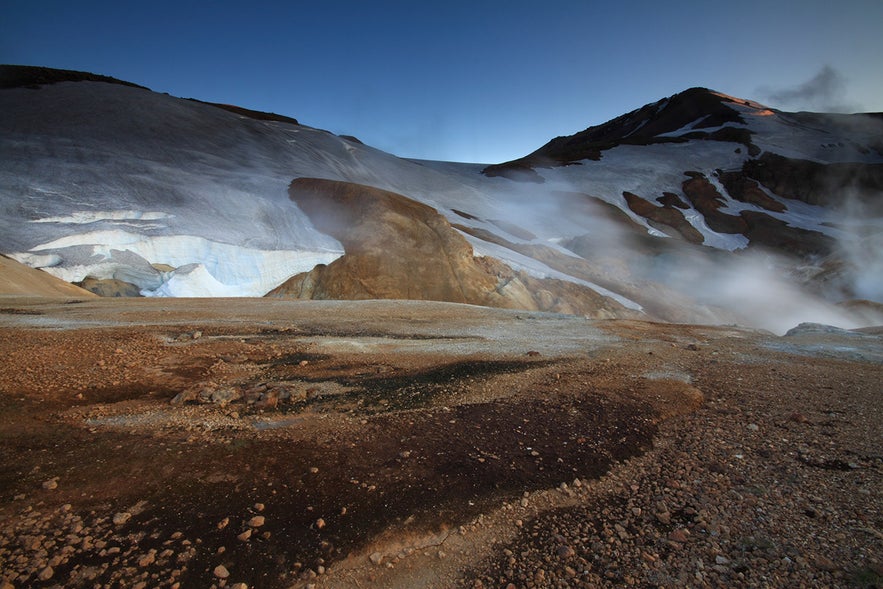
Unlike Vatnajokull, Hofsjokull does not have many named outlet glaciers for tourists to explore, but it’s one of the defining landmarks of the Highlands. The glacier also feeds several major rivers in Iceland, including the Thjorsa River, the longest in the country.
Hofsjokull sits between the Highland routes in Kjolur and Sprengisandur, where rough interior roads are only open to 4x4 vehicles in summer. The surrounding area is barren and volcanic, often inaccessible in winter. For this reason, Hofsjokull is one of the least visited glaciers in Iceland.
Drangajokull Glacier
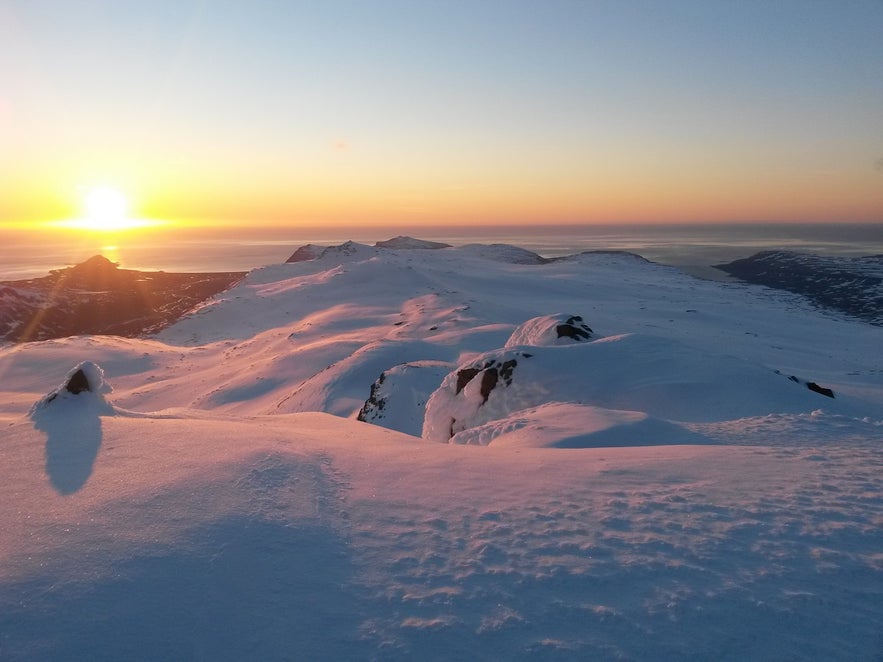
Unlike most glaciers in Iceland, Drangajokull lies at a relatively low altitude, with its highest peak reaching only about 925 meters (3,035 feet).
Because of its size, remote location, and lack of major tour operations, Drangajokull receives very few visitors. It does not have famous outlet glaciers or easily accessible viewpoints, and reaching it usually requires long hikes into the Westfjords interior.
Things To Do on a Glacier in Iceland
Glaciers in Iceland offer many ways to explore beyond simply viewing them from the road. Guided tours make it possible to walk on the ice, enter caves, ride snowmobiles, or even kayak among floating icebergs.
Here are the most popular glacier activities in Iceland.
Glacier Hiking in Iceland
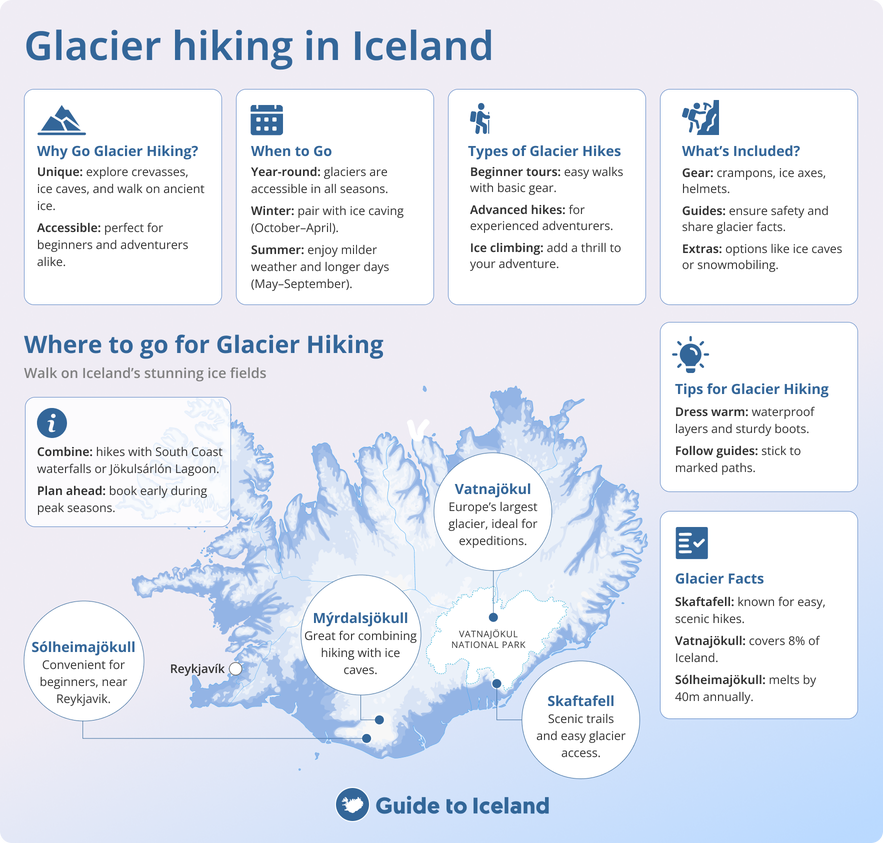
Recommended Glacier Hiking Tours in Iceland
-
Easy & Safe Skaftafell Glacier Hiking Tour: A thrilling experience perfect for beginners.
-
Glacier Discovery Tour on Solheimajokull: An easy guided hike at Solheimajokull.
-
South Coast Adventure With Glacier Hike: Combines a glacier walk with other South Coast highlights.
-
Blue Ice Glacier Hike Experience: Beginner-friendly and focuses on ice formations.
-
5-Hour Skaftafell Glacier Hike: It's a longer, more challenging hike.
-
Iceland Tour With Waterfalls, Glacier Hike, & Northern Lights: A complete experience to make the most of winter in Iceland.
-
South Coast & Glacier Tour With Audio Guide: Adds narration and context to the hike.
Ice Caving in Iceland
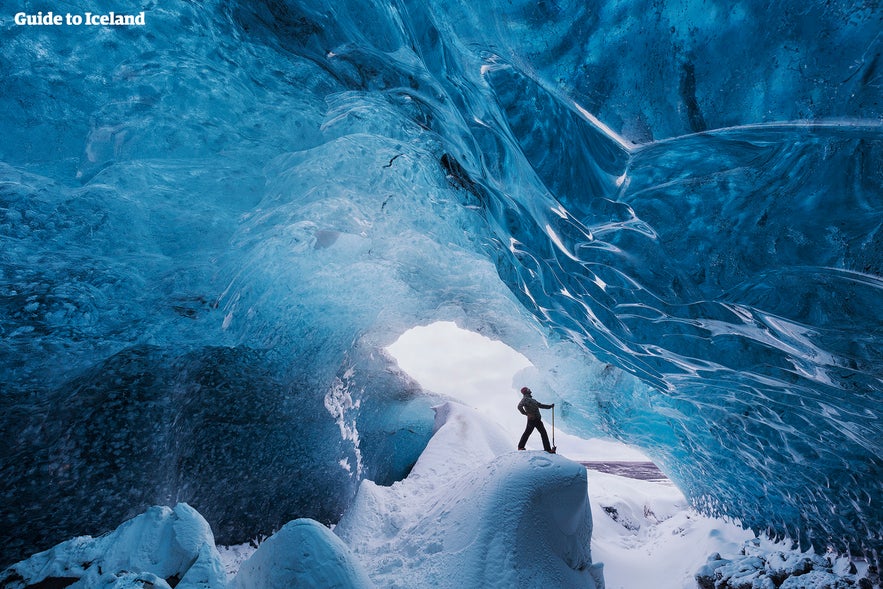
An exception is the Katla Ice Cave, which forms under Kotlujokull, an outlet of Myrdalsjokull near Vik. Thanks to volcanic ash layers that strengthen the ice, this cave can be visited year-round, which makes it one of the few ice caves in Iceland accessible in summer.
Another option is Into the Glacier in Langjokull, a man-made ice tunnel open all year. The tunnel provides a safe and reliable way to explore the blue ice from inside the glacier.
Recommended Ice Caving Tours in Iceland
-
Glacier Caving in Vatnajokull: Tour from Jokulsarlon Glacier Lagoon into a Vatnajokull Ice Cave.
-
Into the Glacier Tour From Reykjavik: Visit the man-made ice tunnel in Langjokull with a stop at Hraunfossar Waterfall.
-
Fast-Track Katla Ice Cave Tour: Quick and easy Katla Ice Cave experience from Vik.
-
Ice Cave Tour With Your Experience Captured: Explore an ice cave with professional photos included.
-
Glacier Hike & Ice Cave Adventure in Vatnajokull: Combines a glacier hike on Vatnajokull with cave exploration.
-
Katla Ice Cave Tour and Glacier Hike: Includes both the ice cave and a glacier hike in Katla from Vik.
-
South Coast & Katla Ice Cave Tour: South Coast sightseeing with an ice cave stop.
-
Moderate Ice Cave Tour & Glacier Hike: A more active option combining glacier hiking and caving.
Snowmobiling in Iceland
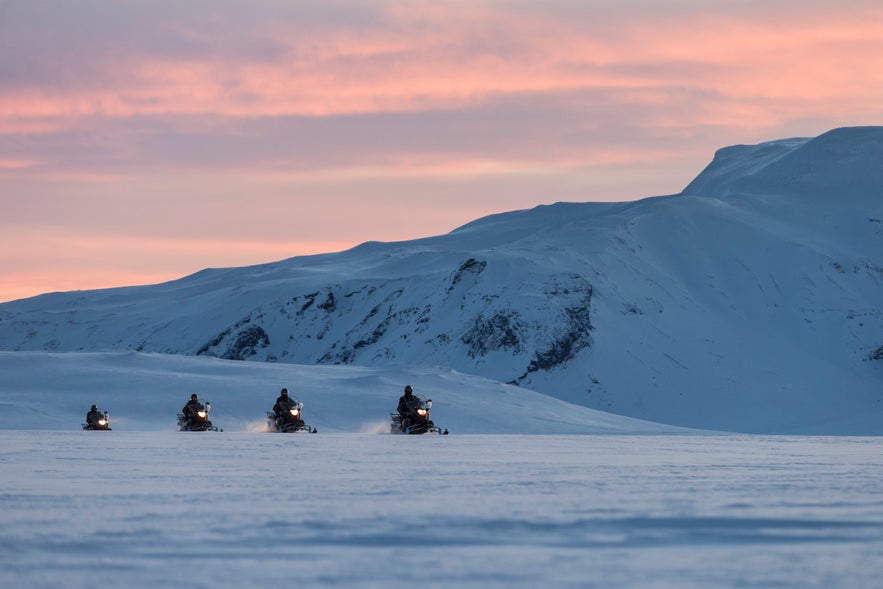
The most popular places for snowmobiling are Langjokull and Myrdalsjokull on the South Coast. Shorter tours are also possible on Eyjafjallajokull and even Vatnajokull.
Recommended Snowmobiling Tours in Iceland
-
Golden Circle & Langjokull Snowmobiling Tour: Classic Golden Circle sightseeing with a snowmobile ride on Langjokull.
-
Golden Circle, Ice Cave, & Snowmobiling Tour: a full-day Golden Circle tour including snowmobiling and an ice cave visit.
-
Snowmobile Tour on Vatnajokull: Explore Europe’s largest glacier by snowmobile.
-
Glacier Snowmobiling & Ice Cave from Geysir: Combines snowmobiling on Langjokull with an ice cave visit.
-
Hot Spring & Cool Glacier Tour: Super Jeep adventure, snowmobiling, plus a relaxing soak in the Secret Lagoon.
-
Eyjafjallajokull Snowmobiling Tour: Quick ride on the glacier made famous by the 2010 eruption.
Kayaking on Glacier Lagoons in Iceland
 Kayaking is a peaceful way to explore Iceland’s glaciers, letting visitors paddle among floating icebergs with views of the glacier walls around them. The most popular lagoons for kayaking are Jokulsarlon, Fjallsarlon, Heinabergslon, and the smaller lagoon at Solheimajokull on the South Coast.
Kayaking is a peaceful way to explore Iceland’s glaciers, letting visitors paddle among floating icebergs with views of the glacier walls around them. The most popular lagoons for kayaking are Jokulsarlon, Fjallsarlon, Heinabergslon, and the smaller lagoon at Solheimajokull on the South Coast.
Recommended Kayaking Tours in Iceland
-
South Coast Kayaking Tour: Paddle on the Solheimajokull Glacier Lagoon, close to the glacier itself.
-
Jokulsarlon Glacier Lagoon Kayaking: Visit the most famous glacier lagoon, where huge icebergs float before reaching the sea.
-
Heinaberg Glacier Lagoon Kayak Adventure: Paddle through a smaller, quieter lagoon near Vatnajokull, with dramatic ice formations.
-
Fjallsarlon Glacier Lagoon Kayaking Experience: Kayak beneath the towering ice wall of Fjallsjokull Glacier.
Ice Climbing in Iceland
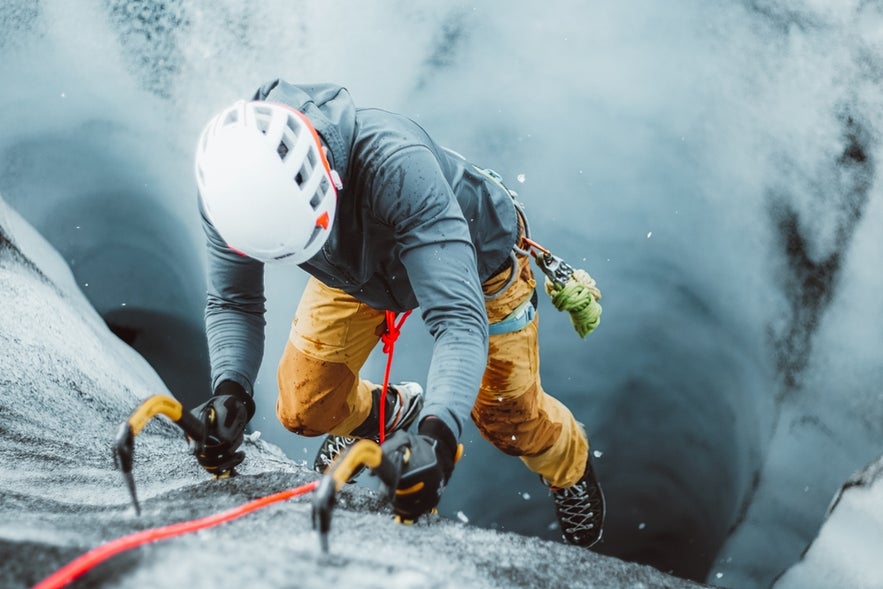 Ice climbing is the most adventurous way to explore glaciers. With crampons, ropes, and an ice axe, climbers scale vertical ice walls under the guidance of experienced instructors. It’s suitable for those in good physical condition.
Ice climbing is the most adventurous way to explore glaciers. With crampons, ropes, and an ice axe, climbers scale vertical ice walls under the guidance of experienced instructors. It’s suitable for those in good physical condition.
Recommended Ice Climbing Tours in Iceland
-
Glacier Hiking & Climbing at Solheimajokull: A glacier hiking and climbing tour at the Solheimajokull Glacier.
-
Skaftafell Glacier Hike With Ice Climbing: Combines glacier hiking and ice climbing in Vatnajokull’s Skaftafell Area.
-
Private Ice Climbing Tour: A custom experience, often better for smaller groups or beginner climbers.
-
Extreme Glacier Hike & Ice Climbing: A challenging glacier-pro level ice climbing and glacier adventure.
FAQs About Glaciers in Iceland
Glaciers are among Iceland’s most popular natural attractions, and many travelers have similar questions before their visit. Here are the most common answers in one place.
What are the names of glaciers in Iceland?
Iceland has hundreds of glaciers, but the main ones are Vatnajokull, Langjokull, Myrdalsjokull, Eyjafjallajokull, Hofsjokull, Drangajokull, and Snaefellsjokull.
What is the easiest glacier to see in Iceland?
Solheimajokull is the easiest to visit, located just off the South Coast’s Ring Road. Langjokull is also easy to access on Golden Circle day tours from Reykjavik.
What are the best glaciers to visit in Iceland?
The best glaciers to visit in Iceland are:
-
Vatnajokull: The largest glacier in Europe, home to Jokulsarlon Glacier Lagoon, Diamond Beach, and the Skaftafell Hiking Area.
-
Langjokull: Ideal for snowmobiling and the Into the Glacier Ice Tunnel, often combined with Golden Circle tours.
-
Myrdalsjokull: Famous for Solheimajokull, one of the easiest places for glacier hiking from Reykjavik, and the Katla Ice Cave.
-
Snaefellsjokull: Smaller, but iconic for its location in Snaefellsnes National Park and literary fame from “Journey to the Center of the Earth.”
What to wear on a glacier hike in Iceland?
Wear warm base layers, a waterproof jacket, hiking boots, gloves, and a hat. Tour companies provide specialized gear like crampons, helmets, and ice axes. The same tips apply if you’re wondering what to wear for ice caving.
Can you hike a glacier in Iceland without a guide?
No. Glacier hikes in Iceland must be done with a certified guide for safety. Glaciers have crevasses and unstable ice, so guided tours are required.
How long is a glacier hike in Iceland?
Most glacier hikes last between two and five hours. Shorter options are available at Solheimajokull, while Skaftafell offers longer routes for those seeking more adventure.
Can you see glaciers in Iceland in summer?
Yes. Glaciers are visible year-round, and guided hikes and snowmobiling are available in summer. Natural ice caves, however, are usually only safe to enter in winter.
Can you climb glaciers in Iceland?
Yes. Ice climbing tours are available for those who want more challenge than hiking. Climbers use crampons and ice axes under expert guidance.
Where is the best place to ice climb in Iceland?
The most popular ice climbing spots are Solheimajokull on the South Coast and Skaftafell in Vatnajokull National Park.
Can I visit a glacier in Iceland?
Yes. Glaciers can be seen from the Ring Road, but the best experiences are through guided activities such as glacier hiking, ice caving, snowmobiling, and kayaking on glacier lagoons.
Explore the Wonders of Glaciers in Iceland
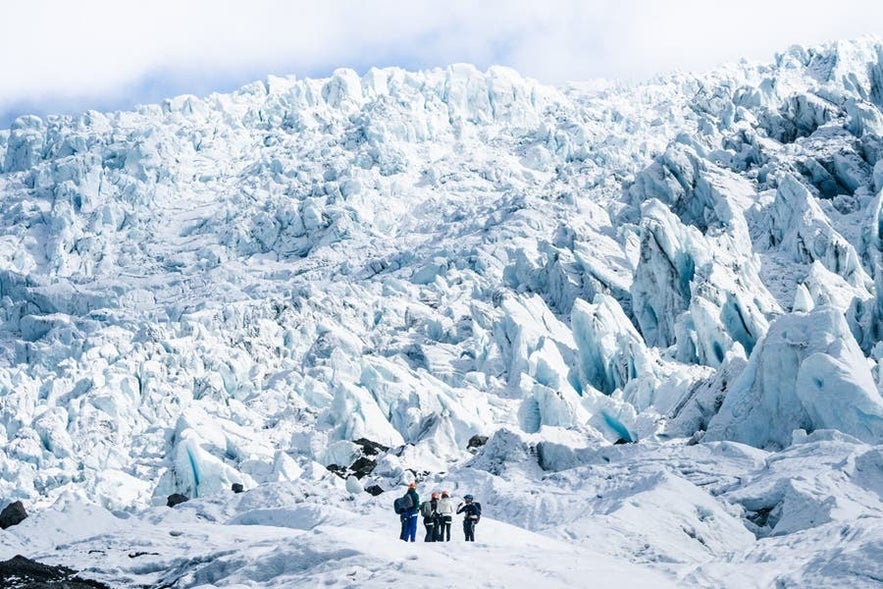 Glaciers in Iceland are living landscapes that change with the seasons. They cover volcanoes, feed rivers, carve valleys, and form lagoons where icebergs float out to the sea.
Glaciers in Iceland are living landscapes that change with the seasons. They cover volcanoes, feed rivers, carve valleys, and form lagoons where icebergs float out to the sea.
For travelers, visiting these glaciers is one of the most unforgettable experiences in Iceland. You can walk on blue ice, explore natural caves, ride snowmobiles across wide white plains, or kayak among drifting icebergs. Few places in the world offer so many ways to explore glaciers in one country.
Which of Iceland’s glaciers would you like to see first: the vast Vatnajokull, the thrilling Langjokull, or the mysterious Snaefellsjokull? Share your answer in the comments below.


